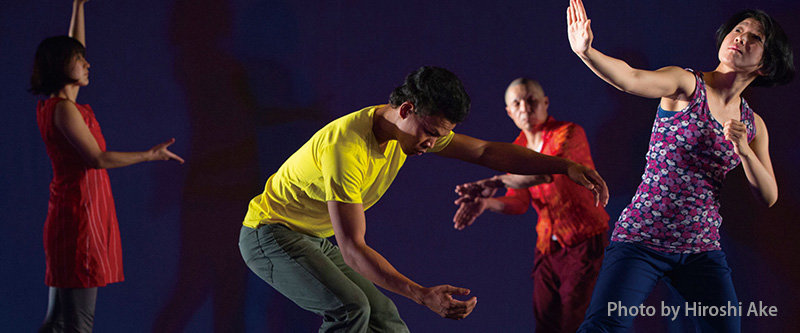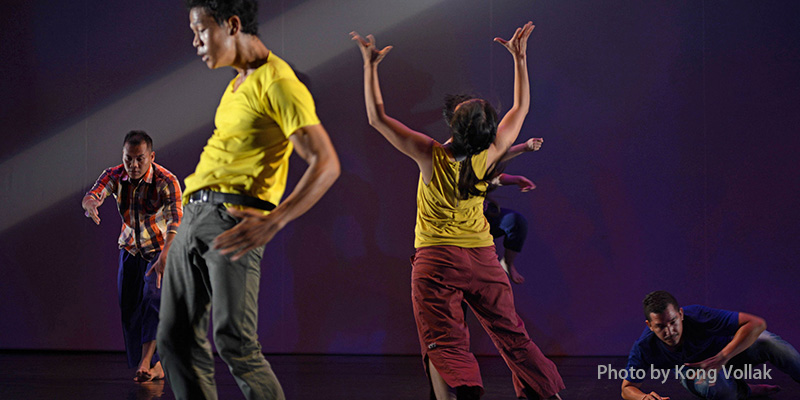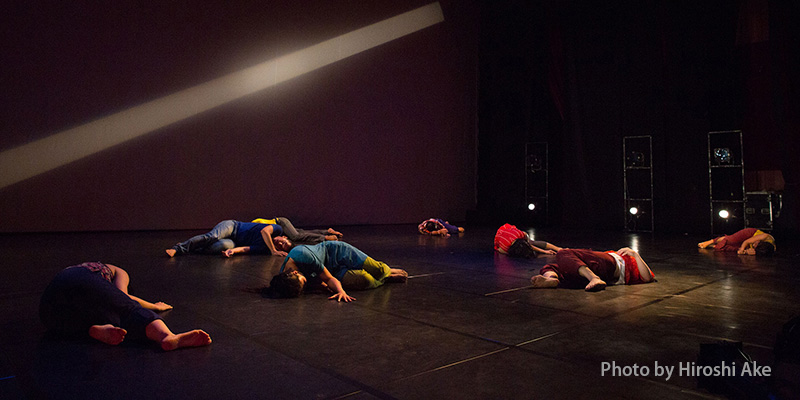


By Junnosuke Tada and Kitamari
in collaboration with choreographer-dancers from around Asia
Junnosuke Tada, a renowned Japanese theatre maker, created Re/Play in 2011 for his theatre company, Tokyo Deathlock. It explores the intent and meaning of re-production through bodily repetition of physical movement. As a re-making of a theatrical production, this version replaces the actors with eight Asian and Japanese leading contemporary choreographer-dancers.
Using pop music, the performers dance until they collapse in exhaustion – and then they get up and do it again, each choreographer-dancer taking a turn at their own approach to the project. This controversial work has an endless structure that subverts the reason and meaning of dance and reveals the urgency of life and chaotic nature of contemporary society.
In a co-production with TheatreWorks, the first international collaboration was presented in Singapore in 2016, followed by a second collaboration in Cambodia in 2017. Further collaborations between Japanese and Asian artists are planned in other countries.

Workshop & Audition: 8-10 May 2017 @ Kyoto Art Center
Performance: 25-26 November 2017 @ Kyoto Art Center
http://www.kac.or.jp/events/22001/
Choreographer-dancers: Kitamari, Tatsuki Imamura, Sheriden Newman, Narim Nam, Chanborey Soy, Aokid, Ayako Saito, Sun Yoshida
Producer: Matsue Okazaki
Stage Manager: Shuji Hamamura
Lighting Designer: Tamotsu Iwaki
Produced by: Kyoto Art Center, Offsite Dance Project, RE/PLAY Dance Edit Committee
Supported by: The Japan Foundation Asia Center, Asahi Group Arts Foundation, The Agency for Cultural Affairs, Government of Japan in the fiscal 2017
Workshop & Audition: 9-10 June 2017 @Steps Dance Studio
Performance: 13-14 January 2018 @Power Mac Center Spotlight
Direction: Junnosuke Tada
Choreographer-dancers: Eisa Jocson, Irish Paul Mendoza, Carissa Adea, John Paul Ortenero, Narim Nam, Sophal Sor, Kitamari, Sachi Masuda
Producer: Matsue Okazaki
Technical Director: Lang Craighill
Lighting Designer: Tamotsu Iwaki
Interpreters: Mayumi Hirano
Co-production: Sipat Lawin Ensemble, Offsite Dance Project, RE/PLAY Dance Edit Committee
Supported by: The Japan Foundation Asia Center, Arts Council Tokyo (Tokyo Metropolitan Foundation for History and Culture)

Born in 1976, Tada formed his company “Tokyo Deathlock” in 2001. His direction focuses on the concept that “manifestation equals phenomenon” and that this manifestation includes a performer’s body, the audience, and the space. With his unconventional approach to the framework of established theater, each of his projects generates intriguing discussions both within Japan and abroad. He has been the artistic director of the Kirari Fujimi Cultural Centre of Fujimi City since 2010. He is the first international winner of the Director Award in the Donga Theater Awards of Korea with the Korean-Japanese collaboration ‘KARUMEGI’ in 2013.
Born in 1983, Kitamari started dancing under the direction of dancer Masami Yurabe. She started working solo upon entering university in 2002 and formed her company “KIKIKIKIKIKI” in 2003. In 2008 she received the Audience Award of the Toyota Choreography Award and the grand prize in the Yokohama Solo X Duo Competition in 2010. She also won the New Artist Award at the Agency for Cultural Affairs National Arts Festival in 2016 for ‘Nachtmusik,’ a part of her series of dances for all of Mahler’s Symphonies. Kitamari continually crosses boundaries by directing, choreographing, and dancing in a range of performances, as well as producing projects that expand the possibilities for performing arts and are vital to the contemporary dance scene.
"RE/PLAY Dance Edit" is based on my play "RE/PLAY," which I created for my theatre company Tokyo Deathlock after the 2011 great earthquake of Northeastern Japan. The premier of “Dance Edit" was at the “We dance Kyoto 2012” dance festival, under the heading of "Theater and Dance/Interchange of Physicality." In this dance performance, I kept same themes of "unrepeatability" and "interruption." I also maintained the structure that expressed life and time ironically through relentless repetition. In the original, actors continued movements without interference from each other. They persistently created and destroyed images from pop music. However, it was indeed the change in physicality, the difference between actors and dancers, that transformed the play into a completely different piece.
Actors, for example, are better at expressing a lonely human because they exist as a human on stage. Dance and dancers, on the other hand, can represent loneliness itself since they express through physicality. For “Dance Edit,” I introduced a new direction: to “dance/not dance.” Through their dance, dancers go back and forth between their humanity and physicality. They go from “person” to “body,” and then from “body” to “dance.” One of the objectives of this piece is to share with the audience performance as something beyond this gradation and preceding that, the contextualization of “theater” and “dance.” Within the framework of time that is constantly repeating and progressing, I also aim to share with audience the questions of “What is dance?” and “What is this world?” I think of the performing arts as a way of sharing questions.
This piece began from the border between theater and dance and then expanded across geographical borders by incorporating performers of various nationalities in Kyoto, Yokohama, Singapore and Cambodia. However, the essence of this piece is not to dismantle borders, but to move forward by overcoming various borders. Each dancer comes face to face with their own body and dance to develop their choreography and their own notions of “dance/not dance.” Diversity is maintained by our acceptance of the various borders that show we are different. The more diversity in bodies, dance perspectives, and cultural backgrounds among the performers, the more vibrant performance will come from the interruption and chaos.
The audience will observe scenes composed by the dancers with a focus on the differences and connections in the concepts of body and dance in Asia. I continue this working on this project in the hope that it provides the chance for not only dance fans, but also many other people in Asia to see various perspectives on what Asia is in the present and future. The performing arts are also a way to express our hopes for the future.
Premiere performance: 4 Feb 2012 / Former Risei Elementary School, Kyoto
Yokohama version: 14-16 Feb 2014 / Steep Slope Studio, Yokohama
Singapore version: 17-20 Feb 2016 / 72-13, Singapore
http://www.wedance.jp/replay/replay2015
https://replay2016.wordpress.com
Cambodia version: 24-25 March 2017 / Department of Performing Arts, Phnom Penh
RE/PLAY Dance Edit Committee
Address: Green Room, 4-1-6 Nishi-nippori, Arakawa-ku, Tokyo Japan 116-0013
E-mail: info@wedance.jp
Offsite Dance Project
Address: 10-1-202 Ikebukuro, Naka-ku, Yokohama, Japan 231-0834
E-mail: info@offsite-dance.jp
URL: http://www.offsite-dance.jp